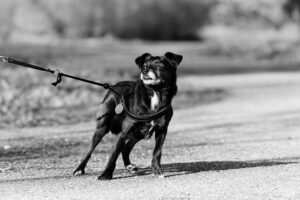
Table of Contents
Introduction
Tired of being dragged down the street by your enthusiastic pup? You’re not alone. Leash pulling is a common challenge for many dog owners, turning what should be a relaxing stroll into a frustrating battle of wills. In this comprehensive guide, we’ll not only explore why dogs pull on the leash, but also equip you with the tools and techniques to learn how to stop leash pulling.
Understanding Why Dogs Pull on the Leash
First things first, why do dogs pull? It’s a multilayered issue rooted in natural behaviors and often reinforced inadvertently by their humans.
The Instinct Behind It
Pulling on a leash is a natural dog behavior, although not inherent to all dogs. For those who do pull, the reasons are usually straightforward – they want to move faster, explore more, and follow scents or movement that pique their interest. This behavior is more pronounced in breeds that were originally bred to work alongside humans, such as huskies or shepherds, who have an innate drive to lead or guide.
The Role of Reinforcement
Apart from their natural instincts, dogs are also great observers of cause and effect. If pulling on the leash leads to something exciting or rewarding (like reaching a beloved park), they learn to repeat it. Often, we unintentionally reinforce this behavior by pulling back or continuing in the direction the dog is pulling, sending the message that pulling equals progress.
Equipment You May Need
Selecting the right equipment can be a game-changer in your battle against leash pulling. Here are a few common tools used to manage this behavior:
The Standard Slip Collar
A slip collar, also known as a choke chain, tightens around the dog’s neck when it pulls. It’s not recommended for all dogs and can lead to throat injuries if used incorrectly or with excessive force. The goal is to use a quick pop and release as direction, not to chock your dog.
The Gentle Leader
A gentle leader fits over your dog’s nose, similar to a horse’s bridle, providing gentle pressure which can help to control pulling. This worked very well for my GSD Jasper regarding the leash pulling, but not so well if there was another dog coming our way. Also just
The Prong Collar
A prong collar consists of metal links with blunt teeth that pinch the dog’s neck when it pulls, providing a corrective sensation. This should only be used under the guidance of a professional trainer, as misuse can result in unnecessary discomfort and injury to the dog. Also, in some dogs the prog collar has the adverse effect of causing the dog to turn back on the handler and occasionally the links break, so they should have a regular collar on as well and a double link leash.
Again, this worked well to stop simple leash pulling for Jasper. It did not work at all, if he was in that hyper-aroused state, a dog reactive dog gets in, when he sees another dog.
No-Pull Harness
These harnesses, often with a front-clip loop that redirects dogs back towards the walker, have gained popularity for their kinder approach to discouraging pulling while eliminating the risk of throat injuries. Some vets do not like the front loop version as they feel over time it can cause deformity. There are other versions of this harness that don’t use front loops. Do your research, and decide for yourself. I never used this one on Jasper, as by the time we got to the prong collar, it had become clear his issue was not leash pulling, but dog reactivity.
When it comes to choosing equipment, always prioritize the health and comfort of your pet. Discuss the options with your vet or a professional trainer to find the best fit for your dog’s breed, size, and individual needs.
Training Techniques to Stop Leash Pulling
Effective training is pivotal in your efforts to end leash pulling. Here are some tried-and-true techniques to consider:
Red Light, Green Light Technique
This technique is straightforward – stop moving forward when your dog pulls. Only progress when the leash is slack. It teaches dogs that pulling doesn’t get them where they want to go faster, and can involve a lot of stopping at first. But consistency will pay off. Another version of this is to simply turn and go the other way. The goal is to teach the dog that pulling does not get them where they want, but coming to you always results in praise and reward.
The Lure and Reward Technique
Employing the help of treats, encourage your dog to walk at your side by their own volition. When they do, reward with a treat or affection. This method works well for dogs motivated by food or who are in the early stages of leash training.
Leash Corrections
For dogs who are particularly strong-willed, leash corrections can be an effective method when done with the right timing and finesse. A gentle pop on the leash can provide a noticeable prompt that you don’t want them to keep pulling. The goal is to pop and release two or three times, and praise and treat when the dog turns to you.
Consistency and Patience
Consistency is key in any training regimen. Reinforcing positive behaviors and not giving in to the pull will help ingrain the desired walking pattern. Be patient; behavior changes take time and repetition. Remember, every walk is a learning opportunity for your dog. Start practicing in your house with no distractions and only slowly add distractions such as a toy on the floor or a treat in a bowl which you will tell your pooch to “leave it” when you pass the distraction.
When to Seek Professional Help
These techniques work well for most dogs. None of them worked for Jasper. Jasper is an 80 pound working line German Shepherd. His genetics drive him to herd and protect. For some reason, Jasper became convinced other dogs were a danger. Also, having a somewhat alpha personality, he looked at any dog as a challenge he needed to deal with. Our work has been about teaching him that is not his job. That is my job, and on any walk we take I am prepared to “deal” with dogs, whose owners do not have them leashed or under control. His job is to do what I tell him.
If you’re finding that your dog remains stubbornly unresponsive to your training efforts, or the leash pulling is becoming a safety concern, it might be time to consult a professional. A certified dog trainer or behaviorist can offer personalized advice and support tailored to your specific circumstances. Please don’t view it as a failure, but rather as a wise investment in your dog’s well-being and the quality of your bond.
I did a great deal of research and preparation before I decided to get Jasper. I did everything right I knew to do. We did puppy class. I worked with him daily from day one. Yet, he developed dog reactivity, and I needed help dealing with my 80 pound, not so small puppy, who could pull me over if he became excited. Jasper and I sought professional help and I am glad we did.
Conclusion
Addressing leash pulling is an important aspect of responsible dog ownership. With the right approach, you can turn frustrating walks into delightful adventures for both you and your canine companion. Remember, patience, consistency, and understanding your dog’s needs are the core pillars of successful training. By taking the time to invest in this training, you are not only creating a safer environment for your walks but also nurturing a deeper, cooperative relationship with your pet. Start implementing these strategies today, and enjoy the transformation in your daily strolls. Your dog (and your arm muscles) will thank you!

